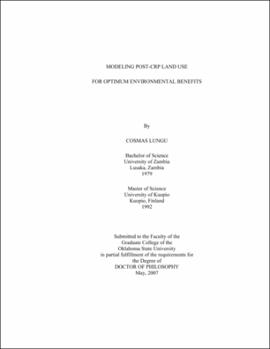| dc.contributor.advisor | O'Connell, Timothy J. | |
| dc.contributor.advisor | Focht, William J. | |
| dc.contributor.author | Lungu, Cosmas | |
| dc.date.accessioned | 2013-11-26T08:29:50Z | |
| dc.date.available | 2013-11-26T08:29:50Z | |
| dc.date.issued | 2007-05 | |
| dc.identifier.uri | https://hdl.handle.net/11244/7109 | |
| dc.description.abstract | Scope and Method of Study: Modeling of the Conservation Reserve Program tracts to maintain environmental benefits in Texas County, Oklahoma by using GIS. | |
| dc.description.abstract | Findings and Conclusions: I used a Geographic Information System to study the effects of the Conservation Reserve Program (CRP) in Texas County Oklahoma. The CRP has brought change to the Texas County landscape resulting in a 16% increase in mean patch size, a 13% reduction in the number of patches, and a 10% reduction in total edge. The CRP has targeted areas important for natural resource conservation. This is illustrated by reduction in area of small grains (17%) and row crops (64%). Some fallow fields (42%) and wetland (19%) have also been placed under the CRP. However, conversion of agricultural land to the CRP has resulted in loss of habitat for some native species. | |
| dc.description.abstract | In terms of post-CRP land management, about 22% of total CRP tracts were identified as suitable to return to row cropping, 70% retained as wildlife habitat, and 8% managed as pasture. Some tracts were identified as being highly vulnerable to soil erosion by water (25%), and wind erosion (0.3%). About 13% of the CRP tracts should be monitored for groundwater quality and about 62% for surface water quality. Modeling results show that all the CRP tracts can be cultivated profitably with marginal soil loss through soil erosion by water. | |
| dc.description.abstract | My conclusion is that environmental benefits of the CRP can be maintained by limiting the amount of land returned to production agriculture. I recommend that most of the retiring CRP tracts should be devoted to wildlife habitat and pasture. I propose that about 22% of the CRP tracts can be returned to row crop production 50% should be retained as wildlife habitat; 8% managed as pasture, and 20% for other uses including conservation programs like the Grassland Reserve Program (GRP) and the Conservation Reserve Enhanced Program (CREP). There should be a policy change in the CRP to allow for commercial usage of conservation lands (e.g. the GRP) and tax incentives should be a component of future conservation policy. | |
| dc.format | application/pdf | |
| dc.language | en_US | |
| dc.rights | Copyright is held by the author who has granted the Oklahoma State University Library the non-exclusive right to share this material in its institutional repository. Contact Digital Library Services at lib-dls@okstate.edu or 405-744-9161 for the permission policy on the use, reproduction or distribution of this material. | |
| dc.title | Modeling post-CRP land use for optimum environmental benefits | |
| dc.contributor.committeeMember | Elliott, N. C. | |
| dc.contributor.committeeMember | Rao, Mahesh N. | |
| osu.filename | Lungu_okstate_0664D_2305.pdf | |
| osu.accesstype | Open Access | |
| dc.type.genre | Dissertation | |
| dc.type.material | Text | |
| thesis.degree.discipline | Environmental Science | |
| thesis.degree.grantor | Oklahoma State University | |
